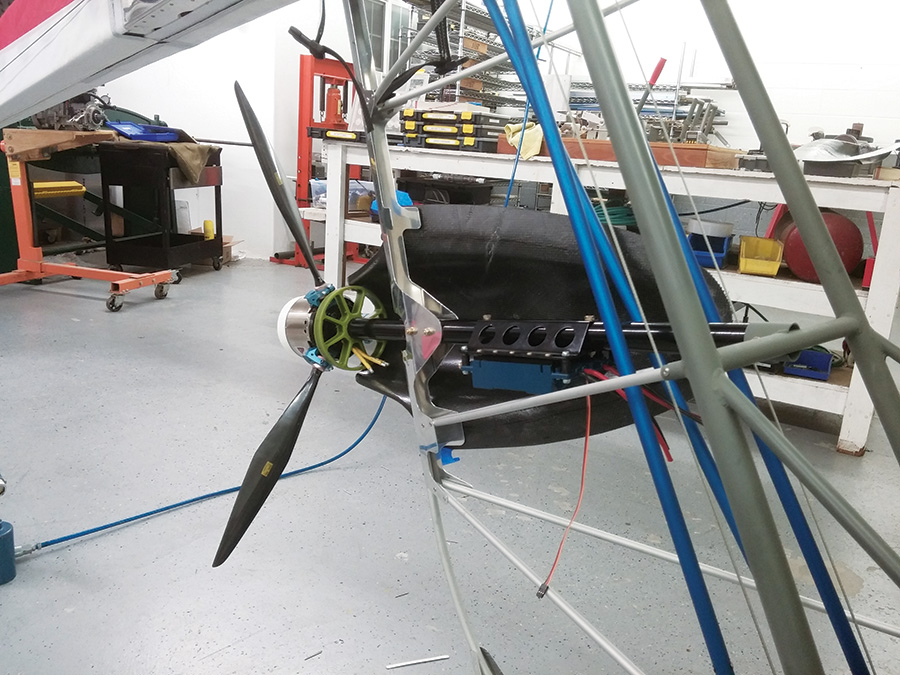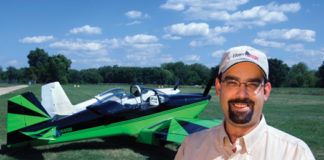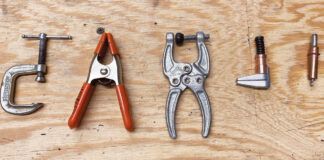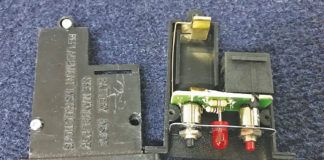For most motors (we can’t get too detailed or complex with the myriad possibilities), the motor controller converts the direct current energy in the battery into alternating current that goes to the motor and makes it rotate. Because different motors run at different voltages, amperages, and different frequencies, the controller and motor must be carefully matched to allow best possible performance and (as an e-bike site put it) “keep the magic smoke inside the batteries and electronics!”

Pulse width modulation turns on and shuts off current flow to the motor. Wider openings (more time that current flows) creates more power at the motor.
Part of the magic in making DC into AC is the controller’s pulse-width modulation (PMW), a process that cuts the direct current into a series of carefully timed pulses of selected duration—a kind of Morse code to the motor.
This digital encoding of the analog battery current changes the always on battery “signal” into a series of “on” and “off” signals to the motor. The more time analog current is “on,” the greater the amount of current gets through.
Modulation is a good term for what the controller does, though. If the pulses were shut off entirely, no current would flow to the motor. If the pulses were opened up to overlap, so that a constant current flowed to the motor, the motor would probably “freeze” and overheat. Modulation in moderation is a very good thing in this case.
In the greatly oversimplified drawings (the only kind I can make), note that, like all digital signals, things are either off or on. When a controller shuts the current off, nothing energizes the motor. When it opens the circuit for the current, that current is at 100% of the battery’s energy, but only for the time it’s flowing—which can be in milliseconds.
Your music CD or movie DVD does much the same, sprinkling clusters of on-off signals of different frequencies that end up emulating the analog wave patterns that make up sound or light.
Getting Real
I asked several builders who’ve successfully flown their own electric creations (or are preparing to do so) what their experience has been and whether they had good advice for those who wanted to try this new form of aerial transit.
The motor is integrated with an electronic speed controller (ESC), which acts as an interface between the batteries and the motor. This controller can be anywhere from the size of a small matchbox to a breadbox (in the ranges we’re considering) and controls the motor speed by sending high-speed switching signals to the coils that ring the perimeter of the motor. Be sure to take into account the physical size of the controller and whether it can be fitted into the available space near the motor.
With a three-phase motor, these signals are phased at 120 degrees. The voltage that gets passed to the motor is based on the amount of time that the switching allows for each phase. By switching in microseconds, the controller permits a lower or higher voltage to drive the motor and increase or decrease its speed.
The speed controller is sized to manage the largest amperage that will be passed to the motor, plus an additional (and nominal) 10 to 20 percent or more to permit occasional excess loads and not damage the controller. Anecdotal evidence shows that wires between motor, ESC, and batteries should be kept as short as practical to prevent damage to the controller. One electric bicycle builder blew three controllers before discovering that sizing and line lengths are important factors.
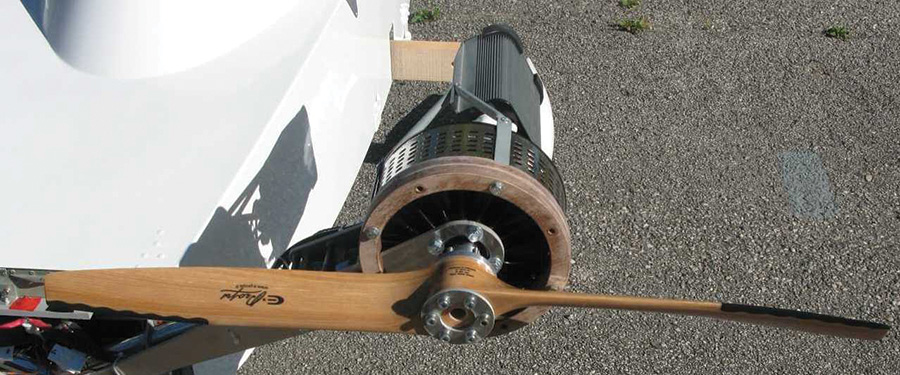
Without streamlined cowling, Electravia’s record-holding Cri-Cri shows close connections between motor, controller. Note longer lines going to batteries inside fuselage.
Getting Similar Answers from Several Experts
I asked these questions as a starting point for discussion:
1. What are your guidelines for a successful motor/controller combination?
2. What contingencies do you take into account in sizing the controller to the motor, other than the correct voltage and maximum amperage that will be drawn by the motor?
3. What line size and length limits do you apply for connecting cables? Between the controller and battery pack? Between the controller and the motor?
4. Are there any special characteristics that you want in a motor controller? For instance, regenerative capabilities?
5. What safety features do you want in a controller?
I received excellent answers from Anne Lavrand at Electravia in France; Mark Bierele, who has flown his e-Gull at Arlington and Oshkosh; Danal Estes, who is developing a motor program for Brian Carpenter’s Rainbow Aviation, Scott Macafee at Joby, and a Chinese representative for Kelly Controllers.
Identifying him or herself only as Fany, Kelly’s Chinese rep let me know that one of their devices has been successfully used on Mark Bierele’s e-Gull. “The controller is our KHB12401. The motor is 30KW BLDC type.
“Our KHB controller is designed by opto-isolated technology. We specify 8-30V for the power supply, which must be isolated from main battery pack. We used dual microprocessors for the KHB controller. The KHB can do regen brake by default.”
Fany noted Kelly’s KBL12401BC has been used on another airplane. It includes CAN bus linkages used for the display on the dashboard. (We will discuss CAN bus and other connecting elements in the next installment.)
Scott Macafee at Joby Motors explained, “We mostly use Castle HV160s as our controllers. In high power setups (> 6 KW), we’ve had the most luck running the motors in a 6-phase configuration with two controllers per motor.
“We’ve got a guy working on a controller right now. I’m not sure how close it is to being flight-ready, but he spins a JM1S at his desk with it regularly.”
Mark Bierele, designer, owner and pilot of the e-Gull, gave a little more detail.
“Each style of motor has its own needs when it comes to the controller. The controller needs to be able to put out its power at the frequency that the motor needs to run at its required rpm. A Joby motor has more poles, so for the same rpm it would need a higher frequency controller. The Joby also runs at a slower rpm because of its larger diameter; this larger diameter allows it to run a prop without a speed reducer. This is an advantage for simplicity.”
He noted cost, availability, and the unit’s track record as prime considerations.
In connecting things, he explained, “It is vitally important to have short cables between motor and controller; the length of cables to the battery is critical due to voltage drop and weight.” Connections require bolting, crimping, and Anderson plugs.
In the most controversial area, Bierele thinks, “Regen is important but not mandatory,” and, “reversing is handy for backing into the hangar.” (Wow your friends with that.)
Low-voltage cutoff is mandatory, according to Bierele, along with a high-voltage cutoff, over-temperature, overspeed, motor over temperature monitoring, and limiting. All these controls protect the batteries and motor. He advises having a high-throttle block to prevent the motor running if the key is turned off when the throttle is advanced. This requires pulling the throttle back to a fully-closed position before the key can be turned back on and the throttle advanced.
Anne Lavrand responded, “Concerning the controllers for electric engines: It is important to have a controller especially for each motor. The characteristics of each electric motor are very different, and the controllers have to be adapted.
“We tried to put a controller for a 25 horsepower motor on another one (same power, quite same characteristics), and it was not a good idea: [resulting in] radio interferences, several problems with power, etc.
“The controller has to be put as close as possible to the motor (within a maximum of 50 centimeters, or 19.7 inches). Then the batteries can be farther. There are no reasonable limits on airplanes. We had about two-meter wires on the E-Light2 between the controller and the batteries.” (Author’s note: this also helped with the center of gravity. However, Electravia no longer provides electric motors, controllers, and batteries. As we went to press, the company announced it “has decided to suspend development, integration and marketing of electric motors in order to concentrate on production of carbon E-Props.” For that reason, we do not include them in our resources section.)
Richard Csuk, vice president of operations for Alltrax controllers, gave a good overview of how to go about matching all the electrical bits and pieces.
“The best advice for choosing a motor controller and motor is to properly size them, not only to the size of the plane but to each other.
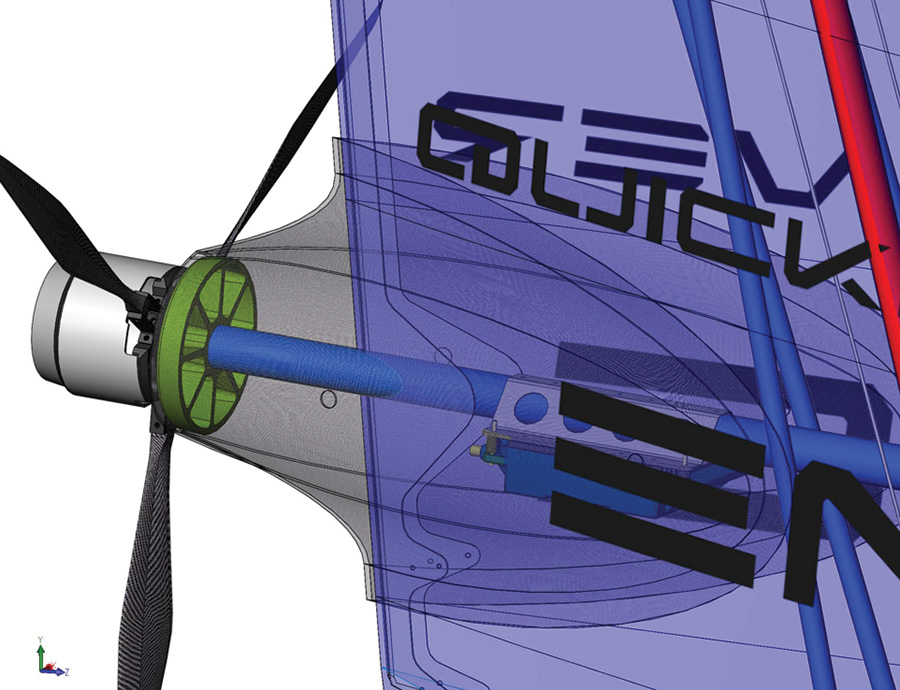
Exploded drawing of Brian Carpenter’s motor installation on EMG-6 shows ducting to direct cooling air to controller and motor. Cooling is necessary, even with the motor’s high efficiency. A 10-kW motor with 95% efficiency would give off 500 watts waste heat. Try touching a 500-watt heat lamp to understand how hot that is.
Motors:
“Too small of a motor for the plane/prop won’t get you the power you need to get off the ground, too big and it’s a waste of money and extra weight. There are three main types of motors available: the series wound, the shunt wound, and AC motors. Each has its benefits and drawbacks. In the grand scheme of things, they are a wash, and it really comes down to the budget.
“The current ratings on motors come in two flavors: peak and continuous. There is no standard for what needs to be on the nameplate, so one company might put peak down and another will use continuous. When in doubt, check with the motor manufacturer. A good rule of thumb is that peak is about 3x the continuous rating. I would recommend a motor with Kevlar banding on the commutator bars. In the event of the motor cutting out and the prop free spinning really fast, it will greatly reduce the risk of centrifugal forces ripping the motor apart when the commutator is spun too fast.
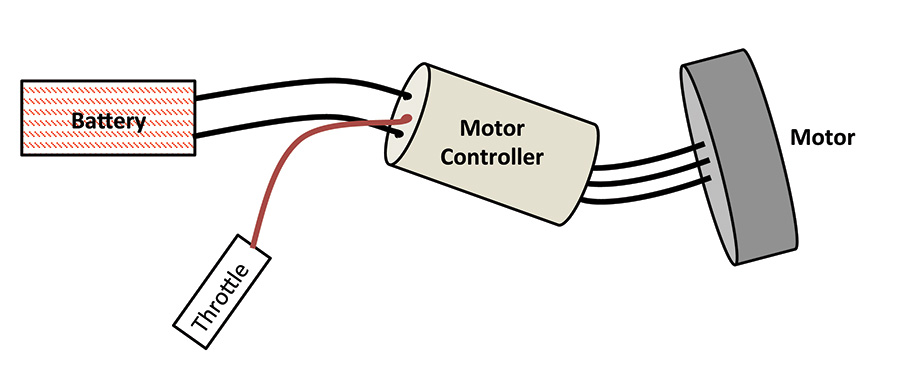
Battery motor controller hookup super simplified: Two lines from battery pack to motor controller and three lines from controller to motor show “conversion” of two-phase to three-phase power. Note additional line to controller for “throttle.”
Controller:
“Size the controller for the motor. Check that the controller’s and motor’s continuous rating are in the same ballpark. Don’t use a controller with a 100A continuous when the motor has a 300A continuous rating; the motor will never get enough torque to do what the pilot needs it to do. If the ratings are close, or fit in between two controller’s ratings, always err on the side of bigger is better.
“Almost all controllers on the market have the ability to be programmed; expect to spend some time dialing in the settings. Each aircraft will be unique, and each pilot has his or her own preferred feel. When laying out the motor/controller/battery system, if the choice comes to having a long run of wires between the controller and the batteries, and the controller and the motor, go with a long run between the controller and the batteries. Distances of more than 20 wire feet between the controller and motor can cause some ringing in the line that will mess up how the motor works; try to keep the motor/controller wire lengths to under 10 feet. [Way under, based on others’ experience.]
Safety:
“I am a firm believer in multiple redundant safety systems on some applications. An aircraft is one such application. All the standard safety systems seen on drawings provided by the controller companies are a good baseline. Install a properly-sized contactor between the batteries and the motor/controller. There is a lot of energy stored in the batteries, so if something were to go south on the motor or the controller, the pilot will want to disconnect the batteries before anything bad happens. I would also recommend a secondary manual disconnect that is easily accessible to the pilot in the cockpit: one of those red emergency mushroom buttons, for instance. That way if the solenoid gets welded shut, the pilot can just hit the button and disconnect everything. All of the wiring should be properly sized—when in doubt go bigger. The only wires we worry about sizing are the battery and motor wires to the controller. Smaller wires can’t carry as much current and can overheat.
“Otherwise, a lot of this is common sense. If something doesn’t look right, ask or go to the next size up.”
Summing Up
General sizing guidelines, both physical and electrical, are remarkably similar for the different users. We’ll look at a few more guidelines in the next article and look at some combinations that have flown successfully, including a “plug-and-play” system that could be a model for all vendors of electric aircraft systems. We’ll also look at a way readers might participate in developing a next generation motor controller.

![]()
Dean Sigler has been a technical writer for 30 years, with a liberal arts background and a Master’s degree in education. He writes the CAFE Foundation blog and has spoken at the last two Electric Aircraft Symposia and at two Experimental Soaring Association workshops. Part of the Perlan Project, he is a private pilot, and hopes to get a sailplane rating soon.

